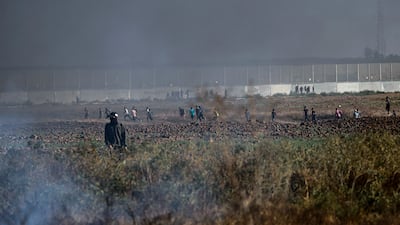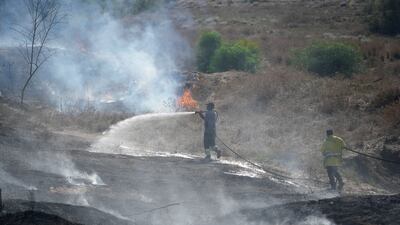Three decades after a US-brokered peace process failed to produce its intended outcome – an independent Palestinian state and with it, peace in the Middle East – experts and former negotiators are now examining what went wrong.
At the heart of why the Oslo peace process failed is whether it was due to flaws in its design or its implementation – or perhaps both.
Experts on both sides agree: the landmark accords signed on the White House lawn in 1993 had several major flaws in design, primarily that they treated both sides of the negotiations – the Palestinian Liberation Organisation and Israel – as equals despite the stark power imbalance.
Shlomo Ben Ami, who served as Israeli foreign minister between 2000 and 2001, said the treaty suffered in both design and implementation.
He said Israel’s insistence on expanding Jewish settlements in the West Bank – areas that had been reserved for a future Palestinian state – even while talks were continuing and few avenues to hold Israel accountable were other major flaws.
“No Israeli commitment to halt expansion of settlements, let alone dismantle them, was in the Oslo Accords,” Mr Ben Ami said at an event hosted by the Middle East Initiative in Washington.
“No system of international observation, no mechanism of sanctions for violators of the agreement – it was all built on the wrong assumption that trust can be built between the occupier and occupied.”
At the time of signing the initial agreement, the sides did not agree on any of the core issues such as the status of Jerusalem, Jewish settlements, borders and Palestinian refugees’ right of return, among others. They instead agreed to reach a permanent settlement on these unresolved issues within five years.
No such agreement happened and over the course of the following three decades, successive US administrations made efforts to get talks started, all of which ended without reaching a final agreement. Most were separated by years of no talks and violent flare-ups.
The last time major direct talks were held was back in 2014.
Omar Dajani, a law professor who served as a member of the Palestinian negotiation team from 1999-2001, said that as the broker of the talks, the US could have made up for the accords' design flaws.
The agreement, he said, left Israel in full control of most of the West Bank, even while the talks were taking place. It also had many ambiguities, which gave Israeli leaders discretion to interpret their commitments as they liked.
And four times between 1993 and 2016, the US used its veto powers on the UN Security Council to prevent measures condemning Israeli settlement activity and create a framework for costs associated with that activity.
“The United States could have played a useful role in compensation for the accords' weaknesses, its choice not to do so should be recognised as the policy failure that it was,” Mr Dajani said.
“They offered cover for unilateral action by Israel.”
Jewish settlements in the West Bank, built on territory Israel occupied in 1967, are considered illegal under international law.
But successive Israeli governments have continued to expand them.
When the accords were signed, about 250,000 Jewish settlers lived in the West Bank and East Jerusalem in 128 settlements, according to Peace Now, an Israeli advocacy group that promotes the two-state solution.
Now, close to 700,000 live in both areas in about 300 settlements and outposts, severely undermining the possibility of having a contiguous Palestinian state.
Last year, Israel voted in its most extreme, right-wing government yet under Prime Minister Benjamin Netanyahu. Since his government was sworn in, settlement expansion has accelerated and cabinet ministers have said they planned on annexing the entirety of the West Bank.
“The far right-wing Israeli government a Benjamin Netanyahu is hoping de facto and eventually de jure to annex the West Bank, their plan is very clear,” said Martin Indyk, who served as US special envoy for Palestinian-Israeli negotiations from 2013-2014.
Clashes near the border between Israel and the Gaza Strip – in pictures
Daniel Kurtzer, a former US ambassador to Israel and Egypt, points to the absence of dispute resolution mechanisms, and a lack of an effective monitoring and accountability mechanism, as major flaws to the peace process.
He said US reports of breaches of the agreement often simply went nowhere.
“Looking in the mirror, I point to failures of American diplomacy and policy,” Mr Kurtzer said.
But he added that there were also failures in the ways in which the negotiations themselves were conducted.
He pointed to Israeli settlement expansion as well as Palestinian suicide bombings, which began soon after the treaty was signed. He said the PLO did not do enough to condemn them.
“The process of peace making has not succeeded or failed as a result of elements of failure within the process of negotiations,” he said.
“They're related to Oslo but they’re much more related to flaws in the way in which all of us negotiated.
“Oslo ended the moment it was signed on the White House lawn.”
Company Profile
Company name: OneOrder
Started: October 2021
Founders: Tamer Amer and Karim Maurice
Based: Cairo, Egypt
Industry: technology, logistics
Investors: A15 and self-funded
Rock in a Hard Place: Music and Mayhem in the Middle East
Orlando Crowcroft
Zed Books
MATCH INFO
Real Madrid 2
Vinicius Junior (71') Mariano (90 2')
Barcelona 0
More on Quran memorisation:
TEACHERS' PAY - WHAT YOU NEED TO KNOW
Pay varies significantly depending on the school, its rating and the curriculum. Here's a rough guide as of January 2021:
- top end schools tend to pay Dh16,000-17,000 a month - plus a monthly housing allowance of up to Dh6,000. These tend to be British curriculum schools rated 'outstanding' or 'very good', followed by American schools
- average salary across curriculums and skill levels is about Dh10,000, recruiters say
- it is becoming more common for schools to provide accommodation, sometimes in an apartment block with other teachers, rather than hand teachers a cash housing allowance
- some strong performing schools have cut back on salaries since the pandemic began, sometimes offering Dh16,000 including the housing allowance, which reflects the slump in rental costs, and sheer demand for jobs
- maths and science teachers are most in demand and some schools will pay up to Dh3,000 more than other teachers in recognition of their technical skills
- at the other end of the market, teachers in some Indian schools, where fees are lower and competition among applicants is intense, can be paid as low as Dh3,000 per month
- in Indian schools, it has also become common for teachers to share residential accommodation, living in a block with colleagues
Avatar: Fire and Ash
Director: James Cameron
Starring: Sam Worthington, Sigourney Weaver, Zoe Saldana
Rating: 4.5/5
Five famous companies founded by teens
There are numerous success stories of teen businesses that were created in college dorm rooms and other modest circumstances. Below are some of the most recognisable names in the industry:
- Facebook: Mark Zuckerberg and his friends started Facebook when he was a 19-year-old Harvard undergraduate.
- Dell: When Michael Dell was an undergraduate student at Texas University in 1984, he started upgrading computers for profit. He starting working full-time on his business when he was 19. Eventually, his company became the Dell Computer Corporation and then Dell Inc.
- Subway: Fred DeLuca opened the first Subway restaurant when he was 17. In 1965, Mr DeLuca needed extra money for college, so he decided to open his own business. Peter Buck, a family friend, lent him $1,000 and together, they opened Pete’s Super Submarines. A few years later, the company was rebranded and called Subway.
- Mashable: In 2005, Pete Cashmore created Mashable in Scotland when he was a teenager. The site was then a technology blog. Over the next few decades, Mr Cashmore has turned Mashable into a global media company.
- Oculus VR: Palmer Luckey founded Oculus VR in June 2012, when he was 19. In August that year, Oculus launched its Kickstarter campaign and raised more than $1 million in three days. Facebook bought Oculus for $2 billion two years later.
Seemar’s top six for the Dubai World Cup Carnival:
1. Reynaldothewizard
2. North America
3. Raven’s Corner
4. Hawkesbury
5. New Maharajah
6. Secret Ambition
Results
6.30pm: Maiden Dh165,000 (Dirt) 1,600m
Winner: Celtic Prince, David Liska (jockey), Rashed Bouresly (trainer).
7.05pm: Conditions Dh240,000 (D) 1,600m
Winner: Commanding, Richard Mullen, Satish Seemar.
7.40pm: Handicap Dh190,000 (D) 2,000m
Winner: Grand Argentier, Pat Dobbs, Doug Watson.
8.15pm: Handicap Dh170,000 (D) 2,200m
Winner: Arch Gold, Sam Hitchcott, Doug Watson.
8.50pm: The Entisar Listed Dh265,000 (D) 2,000m
Winner: Military Law, Antonio Fresu, Musabah Al Muhairi.
9.25pm: The Garhoud Sprint Listed Dh265,000 (D) 1,200m
Winner: Ibn Malik, Dane O’Neill, Musabah Al Muhairi.
10pm: Handicap Dh185,000 (D) 1,400m
Winner: Midnight Sands, Pat Dobbs, Doug Watson.
Yahya Al Ghassani's bio
Date of birth: April 18, 1998
Playing position: Winger
Clubs: 2015-2017 – Al Ahli Dubai; March-June 2018 – Paris FC; August – Al Wahda
The specs: 2018 Chevrolet Trailblazer
Price, base / as tested Dh99,000 / Dh132,000
Engine 3.6L V6
Transmission: Six-speed automatic
Power 275hp @ 6,000rpm
Torque 350Nm @ 3,700rpm
Fuel economy combined 12.2L / 100km
Ant-Man%20and%20the%20Wasp%3A%20Quantumania
%3Cp%3E%3Cstrong%3EDirector%3A%20%3C%2Fstrong%3EPeyton%20Reed%3Cbr%3E%3Cbr%3E%3Cstrong%3EStars%3A%3C%2Fstrong%3E%20Paul%20Rudd%2C%20Evangeline%20Lilly%2C%20Jonathan%20Majors%3Cbr%3E%3Cbr%3E%3Cstrong%3ERating%3A%20%3C%2Fstrong%3E2%2F5%3C%2Fp%3E%0A
COMPANY%20PROFILE
%3Cp%3E%3Cstrong%3ECompany%20name%3A%3C%2Fstrong%3E%20Switch%20Foods%3Cbr%3E%3Cstrong%3EStarted%3A%3C%2Fstrong%3E%202022%3Cbr%3E%3Cstrong%3EFounder%3A%3C%2Fstrong%3E%20Edward%20Hamod%3Cbr%3E%3Cstrong%3EBased%3A%3C%2Fstrong%3E%20Abu%20Dhabi%2C%20UAE%3Cbr%3E%3Cstrong%3EIndustry%3A%3C%2Fstrong%3E%20Plant-based%20meat%20production%3Cbr%3E%3Cstrong%3ENumber%20of%20employees%3A%3C%2Fstrong%3E%2034%3Cbr%3E%3Cstrong%3EFunding%3A%3C%2Fstrong%3E%20%246.5%20million%3Cbr%3E%3Cstrong%3EFunding%20round%3A%3C%2Fstrong%3E%20Seed%3Cbr%3E%3Cstrong%3EInvestors%3A%3C%2Fstrong%3E%20Based%20in%20US%20and%20across%20Middle%20East%3C%2Fp%3E%0A
Four%20scenarios%20for%20Ukraine%20war
%3Cp%3E1.%20Protracted%20but%20less%20intense%20war%20(60%25%20likelihood)%3C%2Fp%3E%0A%3Cp%3E2.%20Negotiated%20end%20to%20the%20conflict%20(30%25)%3C%2Fp%3E%0A%3Cp%3E3.%20Russia%20seizes%20more%20territory%20(20%25)%3C%2Fp%3E%0A%3Cp%3E4.%20Ukraine%20pushes%20Russia%20back%20(10%25)%3C%2Fp%3E%0A%3Cp%3E%3Cem%3EForecast%20by%20Economist%20Intelligence%20Unit%3C%2Fem%3E%3C%2Fp%3E%0A
The specs
Engine: 1.5-litre 4-cyl turbo
Power: 194hp at 5,600rpm
Torque: 275Nm from 2,000-4,000rpm
Transmission: 6-speed auto
Price: from Dh155,000
On sale: now
The biog
Nickname: Mama Nadia to children, staff and parents
Education: Bachelors degree in English Literature with Social work from UAE University
As a child: Kept sweets on the window sill for workers, set aside money to pay for education of needy families
Holidays: Spends most of her days off at Senses often with her family who describe the centre as part of their life too
Full Party in the Park line-up
2pm – Andreah
3pm – Supernovas
4.30pm – The Boxtones
5.30pm – Lighthouse Family
7pm – Step On DJs
8pm – Richard Ashcroft
9.30pm – Chris Wright
10pm – Fatboy Slim
11pm – Hollaphonic
More on Quran memorisation:
Killing of Qassem Suleimani












